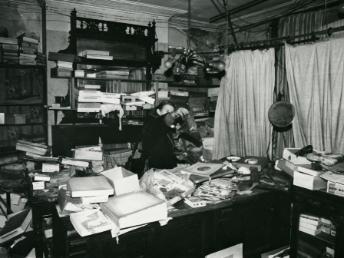
Corsets, cocktail dresses and utility clothes – project charts a history of fashion and museums
Corsets, cocktail dresses and utility clothes – project charts a history of fashion, shopping and museums
A museum’s collection of unsold shop stock has inspired a researcher to investigate attitudes towards ‘everyday’ clothing and its history.
The Hodson Shop Collection features thousands of items from a small drapers shop in Willenhall that ran from 1920 until the early 1970s.

The shop was opened in the front room of the Hodson family home on New Road in 1920 by Edith Hodson and her younger sister, Flora, entered the business in 1927. They lived there together their whole lives.
The sisters kept all unsold stock and this fascinating collection was discovered in 1983 and passed on to Walsall Museum where it was painstakingly catalogued by Honorary Curator of Costume, Sheila Shreeve.
Jenny Gilbert-Evans, Postgraduate Researcher in Dress History and Visiting Lecturer at the University of Wolverhampton, has spent three years studying the collection and gaining insight into changing attitudes to fashion and shopping trends throughout the decades.

Working with Walsall Museums Service and funded by the Arts and Humanities Research Council’s Collaborative Doctoral Awards programme, she has put together a biography of a museum collection and examined the history of the stock – from Edwardian bloomers to utility clothing and colourful, full skirts from the 1950s.
Jenny, who was supervised by Professor of History Laura Ugolini, said: “Very little is currently understood about how attitudes alter towards garments as they become museum items. While luxurious and elite fashion is a common feature of many local and national museum costume collections, collections of ‘everyday’ clothing are often overlooked.”
She said: “When you look at the collection, you can clearly see an evolution of clothing. One of the most marked differences was in underwear.
“There was a gradual decline in the use of corsetry and ladies’ underwear became increasingly skimpy and dainty. Wool and silk became used less as nylon became more popular, reflecting fashion and synthetic innovation.
“Opening a box of lipsticks from the 1940s felt like Christmas; they looked and smelt amazing. Wholesaler catalogues were like mini works of art, beautifully hand illustrated, although the contents were often just lists of products. It was fascinating to see how much care went into producing such a mundane object.
“There was also utility clothing produced during the Second World War, made to strict standards.”

Jenny said it had been fascinating working on the collection, which has formed the basis of her doctoral thesis: “Collections like this are rare and overlooked and that is a threat to the history of everyday life – it is the heritage of people who are not famous or part of the elite yet still have fascinating stories to reveal.”
The Hodson Shop Collection is on display at Walsall Leather Museum until January 21.
Further information
Pictured is Jenny helping to display 1940s dresses from the collection.
The Arts and Humanities Research Council (AHRC) funds world-class, independent researchers in a wide range of subjects: ancient history, modern dance, archaeology, digital content, philosophy, English literature, design, the creative and performing arts, and much more. This financial year the AHRC will spend approximately £98m to fund research and postgraduate training in collaboration with a number of partners. The quality and range of research supported by this investment of public funds not only provides social and cultural benefits but also contributes to the economic success of the UK. For further information on the AHRC, please go to:www.ahrc.ac.uk
For more information please contact the Corporate Communications Team.


/prod01/wlvacuk/media/departments/digital-content-and-communications/images-2024/240328-Varsity-Line-Up-Resized.jpg)
/prod01/wlvacuk/media/departments/digital-content-and-communications/images-18-19/220325-Engineers_teach_thumbail.jpg)
/prod01/wlvacuk/media/departments/digital-content-and-communications/images-2024/240404-Digital-Humanities-Training-Resized.jpg)
/prod01/wlvacuk/media/departments/digital-content-and-communications/images-2024/240320-Uzbekistan-Resized.jpg)
/prod01/wlvacuk/media/departments/digital-content-and-communications/images-2024/240229-The-Link-Resized.jpg)
/prod01/wlvacuk/media/departments/digital-content-and-communications/images-2024/240404-Pharmacy-Students-Resized.jpg)

